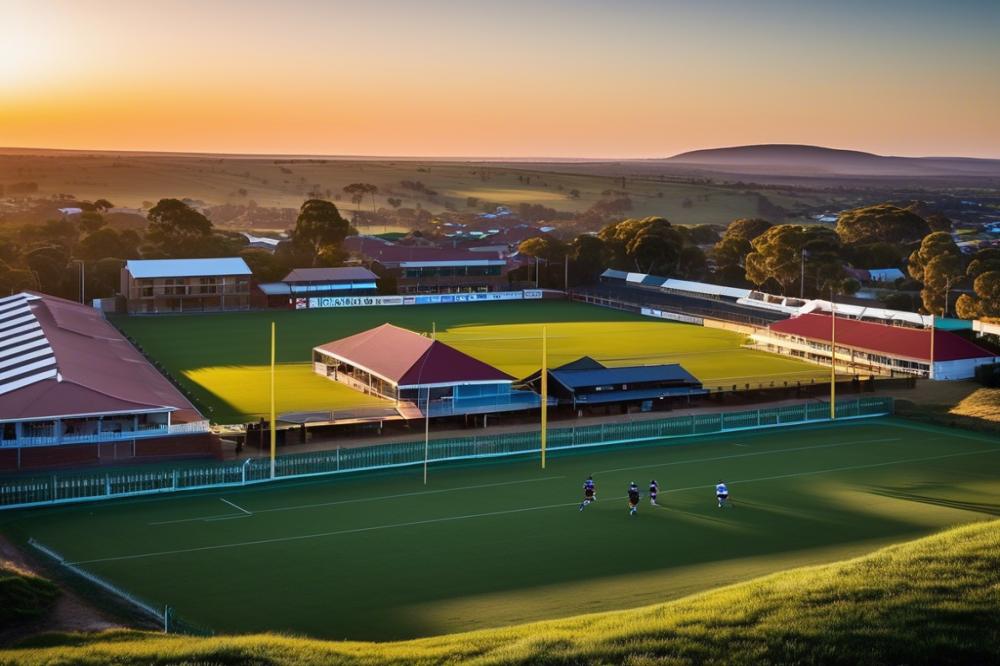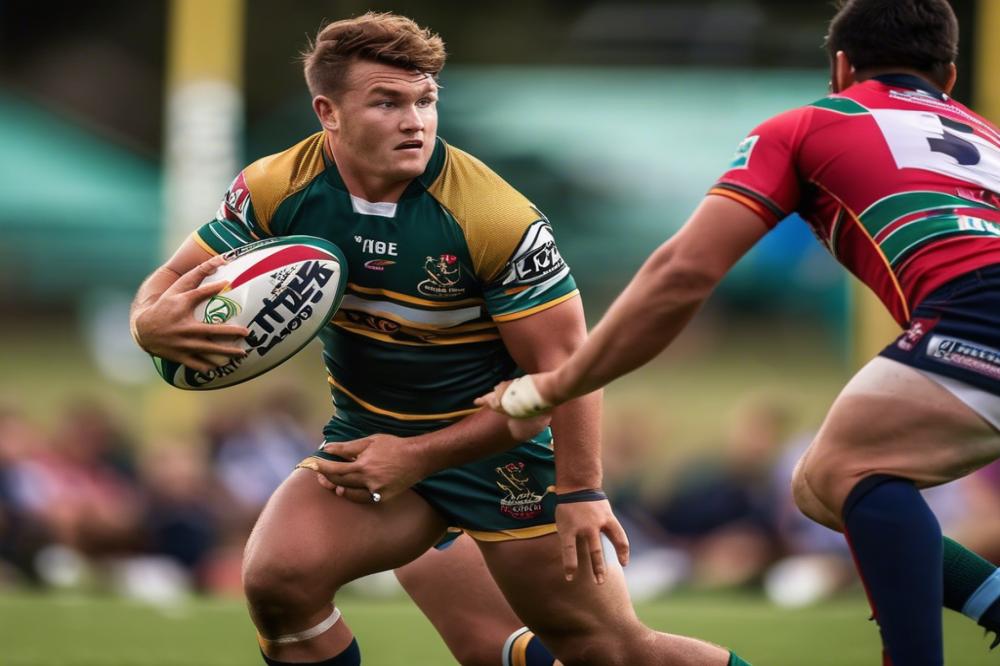From Small Towns to Rugby Giants
Rugby league is a sport full of passion, intensity, and remarkable talent. It captivates audiences across continents and brings communities together. In the midst of this rich tapestry, it is notable how many standout players hail not from big cities, but from small towns. These unassuming locales seem to nurture some of the game’s greatest stars, creating a fascinating narrative worth exploring.
The journey from a modest town to the global stage is a remarkable one. It highlights the dreams and aspirations that propel talented individuals forward, despite their humble beginnings. Rugby league, a sport played with #utmost commitment, has seen numerous iconic figures emerge from such environments. Whether it’s the countless hours on local fields or the tight-knit community support, small towns have a nurturing essence that appears to produce extraordinary skills.
This article delves into this phenomenon, examining how small towns contribute to nurturing eminent #rugby players. We will analyze the pathways these athletes traverse, the support systems they benefit from, and the challenges they overcome. By doing so, we hope to uncover how these communities play a crucial role in the global landscape of rugby league. We’re excited to take you on this exploration of talent unearthed in the most unexpected places.
How Small Towns Are a Breeding Ground for Talent

Small towns have often been overlooked in the discussion of sporting talent. However, these humble locations are instrumental in cultivating top rugby league players. They possess certain qualities that help nurture remarkable talent. From providing a supportive network to offering accessible facilities, small towns quietly fuel the engines of athlete development.
The Power of Close-Knit Communities
In small towns, everyone knows each other. This connectedness fosters a supportive environment. Young athletes find encouragement from neighbors, teachers, and local business owners. In such a setting, players receive not just verbal motivation, but sometimes even financial support. This strong foundation is a significant asset to developing athletes. They feel part of something greater, important in building confidence and resilience.
The Influence of Local Sports Culture
Many small towns have a deep-rooted love for sports, especially rugby. This passion is often passed down through generations. Kids grow up watching local games, dreaming of playing in the big leagues. The games become community events, drawing crowds. With this vibrant atmosphere, young players are inspired daily. Local legends and former players often serve as mentors, guiding the next generation.
Access to Sports Facilities
Unlike big cities, where sports facilities can be overcrowded, small towns offer easier access. There, children spend hours on local fields honing their skills. Many towns invest in quality pitches and basic training equipment. While not always state-of-the-art, these facilities provide ample opportunity for practice. The absence of lavish distractions allows athletes to focus entirely on improvement. Because of these simple resources, players learn to work with what they have.
Historical Contributions to Rugby League

Small towns have often punched above their weight in producing top-notch rugby league talents. These communities might lack the hustle and bustle of large cities, but they make up for it with grit and passion. Over the years, countless players have risen from humble beginnings to make significant marks on the sport.
Review Notable Rugby League Players from Small Towns
One standout is Jonathan Thurston, who hails from the small town of Toowoomba, Australia. Thurston’s skill and leadership on the field have made a lasting impression on the league. Another example is Wigan’s own Shaun Edwards, who became a rugby league legend with his incredible gameplay.
Discuss the Historical Impact of These Players on the Game
Their contributions extend beyond personal achievements. Players from small towns have shaped the game’s evolution, bringing diversity in techniques and strategies. By consistently outperforming expectations, they have proven that talent knows no geographical boundaries. This influence has been felt in both national and international arenas, pushing the game’s development to new heights.
Highlight Key Examples and Success Stories
Consider Andrew Johns from Cessnock, Australia. His exceptional career saw him earn numerous accolades, including being named Rugby League Immortal. Billy Slater, originating from Innisfail, Australia, became a household name, known for his speed and agility on the field. Each has inspired countless young players, emphasizing the potential hidden within small communities.
Community Engagement and Support

Investigate the Role of Grassroots Programs in Small Towns
Grassroots programs play a pivotal role in nurturing future stars. These initiatives often begin in humble surroundings, focusing on teaching fundamental skills. Young athletes benefit from coaches who are deeply embedded in their communities. Committed volunteers dedicate countless hours, fostering a love for rugby league among children. Small towns lack the resources of larger cities, yet their passion often compensates for this shortfall. Community centers and schools collaborate to offer training facilities, making the sport accessible to everyone.
Explore How Local Leagues and Initiatives Foster Talent
Local rugby leagues act as a breeding ground for budding talent. Here, boys and girls alike grasp tactics and team spirit. Competitions organized by these leagues provide the first taste of competitive play for many young athletes. Many legends of the game recall their first tackle or try on these familiar pitches. Coaches, often former players themselves, pass down invaluable wisdom and experience. Small-town clubs are adept at recognizing potential, nurturing it with a personal touch. As they progress, players move through various levels, gaining skills and confidence.
Discuss the Importance of Community Backing for Young Athletes
Young athletes thrive under the unwavering support of their local community. Families, friends, and neighbors fill the stands during matches, offering encouragement from the sidelines. This support forms a tight-knit network that bolsters their spirits. Fundraising events provide essential financial backing, helping cover travel costs and equipment expenses. Inspirational stories of players from their town achieving success motivate others. Young athletes understand the significance of representing their town, fueling their drive to succeed. Community pride becomes a powerful motivator, pushing them to reach new heights.
Challenges and Opportunities
Young athletes from small towns often face significant obstacles when aiming for rugby league stardom. Limited access to top-tier coaching can hinder their development. Many small-town players lack exposure to competitive leagues. Geographic isolation adds to these hurdles, making travel for games and training a daunting expense. Without local clubs that compete regularly, staying in peak condition is even harder. Financial burdens can deter promising players from pursuing their dreams.
Despite these difficulties, several avenues offer hope for dedicated young athletes. Scouting networks have expanded into rural areas, providing greater visibility for hidden talents. Partnerships between local schools and larger clubs have opened doors for rural youth. Technology also plays a vital role; video sharing can showcase talent to a wider audience without the need for constant travel. Ambitious athletes can now stay connected and informed through online platforms. Community support remains a strong pillar, often rallying behind their local heroes.
Programs designed to bridge the gap are making a real difference. Scholarships for regional players give them a leg up in competitive environments. Initiatives like development camps allow young athletes to train alongside seasoned professionals. Several national leagues have established outreach programs to discover and nurture talent from less populated areas. Academies targeting rural youth foster not only skill but also discipline and sportsmanship. By providing structured pathways, these programs level the playing field for small-town players.
Personal Stories and Case Studies
Inspiring Journeys from Small Towns
Many of rugby league’s finest athletes hail from unexpectedly humble origins. Take Johnathan Thurston, an iconic player who grew up in the small town of Toowoomba in Queensland, Australia. He learned the basics of rugby league on neighborhood fields with friends, before catching the eye of local coaches. Despite challenges faced, Thurston did not falter. His perseverance paid off with a successful career in the NRL.
From Local to National Stage
For some, reaching the professional leagues seemed a distant dream. Consider the case of Andrew Fifita from Blacktown, New South Wales. His journey began at the local junior club, where he honed his technical skills and sportsmanship. Coaches noticed his promise. Encouragement from mentors played a critical role. As he advanced through the ranks, Fifita’s talent became undeniable, leading to his selection for the NRL.
A Journey Worth Witnessing
Every step of the journey to the National Rugby League (NRL) level involves dedication. Kalyn Ponga, originally from Port Hedland, Western Australia, stands as another beautiful success story. His family moved often due to his father’s work. Yet, every town brought new opportunities for Kalyn’s growth on the field. Each match he played added to his learning, ultimately culminating in an electrifying debut with the Newcastle Knights.
Enabling Local Talent
Local clubs form the heart of these journeys. Regular training sessions and community support provide a safety net for aspiring athletes. Coaches at these clubs exhibit unwavering commitment to their players. They not only focus on skill development but also teach the values necessary for life both on and off the field. Their dedication fosters an environment where ambition can transform into achievement, allowing players from small towns to excel at the highest levels.
The Pathway to Success
Reaching the NRL embodies more than personal success; it’s about communities witnessing their young talents shine. Each player’s story is different, marked by unique hurdles. Nonetheless, their achievements reflect the strength and passion grassroots rugby league instills. Players, such as those mentioned, charted their journeys with a robust support system and relentless drive. They illustrate how small towns, given the right resources and attention, can indeed produce some of rugby league’s best players.
Modern Pathways for Developing Small-Town Talent
Rugby league has evolved significantly over the years, creating new opportunities for young athletes from small towns to shine on a large stage. The National Rugby League (NRL) has been pivotal in crafting pathways that cater to diverse talent, ensuring those in remote areas are not overlooked. Various avenues exist today for budding stars to develop their skills and be recognized by professional teams.
The Role of Academies and Scouting Networks
Academies have become vital in nurturing aspiring players. NRL clubs invest in these programs, providing young athletes with world-class training facilities and expert coaching. Such environments offer more than just skill development; they instill discipline, sportsmanship, and the ability to thrive under pressure.
Scouting networks reach deep into rural regions, seeking hidden gems in lesser-known locales. Scouts focus on identifying potential, often traveling significant distances to watch players in local competitions. They play a key role in helping undiscovered athletes get noticed by professional clubs. Scouts are critical in bridging the gap between small-town dreamers and their ambitions.
The Evolving Landscape of Talent Development in the League
Changes in the league have brought about innovative approaches to talent cultivation. Clubs are adapting to new technologies, using video analysis and data tracking to assess players more precisely. These tools allow for better evaluation of skills, even from afar, making it easier to compare athletes against established benchmarks.
Moreover, partnerships with educational institutions are becoming common. Such collaborations offer young players an academic pathway alongside their athletic pursuits. Balancing school and sport can be challenging, but these partnerships nurture well-rounded individuals ready for life’s demands.
The future of rugby league is increasingly inclusive. By opening doors for small-town talent, the NRL continues to diversify its player base, infusing fresh vigor into the sport. As these pathways mature, rural players will have greater opportunities to impact the highest levels of rugby league.
The Legacy of Small Towns in Rugby League
Small towns have been the cradle of some of rugby league’s finest talents. These communities, with their close-knit fabric, have produced athletes who exhibit grit and determination. The unique culture and training conditions found in these locales often forge distinct player profiles, standing as testament to the power of local pride and community spirit.
Throughout our exploration, we discovered how the intimate nature of small towns fosters strong bonds among aspiring players. The mentorship and support from local coaches and families frequently play vital roles. Without the distractions often found in larger cities, these athletes focus early on honing their skills. The drive and passion they cultivate in these environments are invaluable.
From childhood games on local fields to professional careers, many top-tier players have carried their hometown values onto the global stage. We’ve seen how local investment in sports facilities and community clubs can catalyze this development. Stories of legends born on scattered patches of turf remind us that the heart of rugby league beats strongly outside major urban centers.
Looking ahead, it’s crucial to continue nurturing talent in these vibrant communities. Programs that support grassroots training and infrastructure will likely yield future stars. Re-evaluating and enhancing the pathways for emerging players from small towns can only enrich additional contributions to the sport. As we cherish the past, let’s also look forward to a thriving future for rugby league player development.
Ultimately, the true spirit of rugby lies in its heroes who hail from humble beginnings. The undying passion of these communities stands as a beacon of resilience and strength. Rugby league’s future shines brighter with each player who emerges from these towns, proving that no background is insignificant when determination is at play.
#anchor_text_3# and #anchor_text_4# reflect the ongoing legacy and promise embedded in small town rugby league stories.



